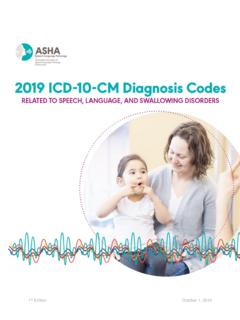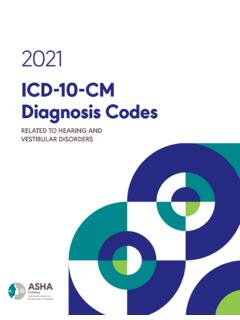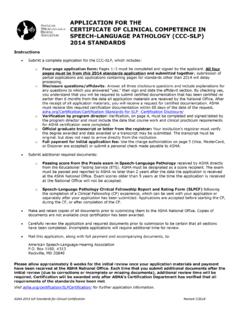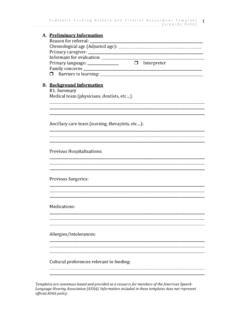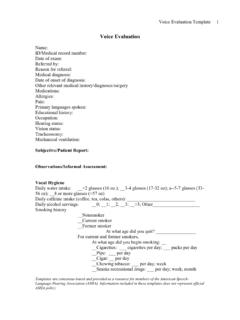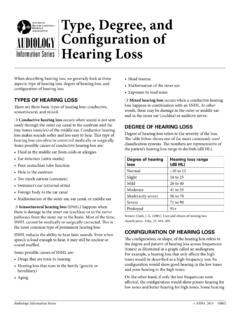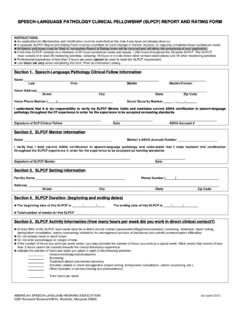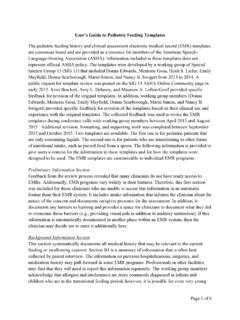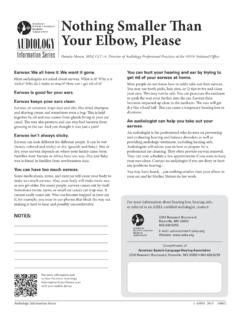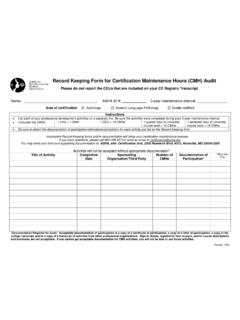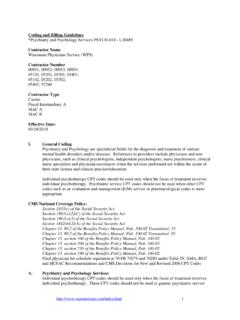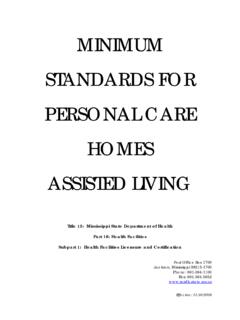Transcription of ICD-10-CM Diagnosis Codes - American Speech–Language ...
1 2260512022 ICD-10-CM Diagnosis CodesRELATED TO speech , LANGUAGE, AND SWALLOWING DISORDERSS peech-Language PathologyDedicated to Advancing the Profession of speech -Language Pathology226051 First Edition October 1, 2021 General Information The American speech -Language-Hearing Association (ASHA) developed this curated list of 2022 International Classification of Diseases, Tenth Revision, Clinical Modification ( ICD-10-CM ) Diagnosis Codes for speech -language pathologists (SLPs) reporting speech , language, communication, and swallowing disorders. The 2022 ICD-10-CM is effective October 1, 2021. This resource is not exhaustive, and a number of Codes and sections are included for information purposes only. Entries with only three or four digits may require coding to a higher degree of specificity than indicated here.
2 However, in general, speech -language pathology related diagnoses are listed to their highest level of specificity. Visit ASHA s coding and payment website for additional ICD-10-CM resources at For a list of new and revised ICD-10-CM Codes effective October 1, 2021, see For additional information, contact the health care and education policy team at Table of Contents General Information .. 1 ICD-10-CM Diagnosis Codes .. 3 Overview .. 3 Scope .. 3 Purpose .. 3 Relation to Professional Scope of Practice .. 3 Official ICD-10-CM Resources .. 3 ASHA Resources .. 3 Instructional Notations .. 4 ICD-10-CM Tabular List of Diseases and Injuries .. 5 Ch. 1: Certain infectious and parasitic diseases (A00-B99) .. 5 Ch. 2: Neoplasms (C00-D49) .. 5 Ch.
3 4: Endocrine, nutritional and metabolic diseases (E00-E89) .. 8 Ch. 5: Mental, behavioral, and neurodevelopmental disorders (F01-F99) .. 8 Ch. 6: Diseases of the nervous system (G00-G99) .. 17 Ch. 9: Diseases of the circulatory system (I00-I99) .. 23 Ch. 10: Diseases of the respiratory system (J00-J99) .. 29 Ch. 11: Diseases of the digestive system (K00-K95) .. 33 Ch. 13: Diseases of the musculoskeletal system and connective tissue (M00-M99) .. 34 Ch. 16: Certain conditions originating in the perinatal period (P00-P96) .. 39 Ch. 17: Congenital malformations, deformations and chromosomal abnormalities (Q00-Q99) .. 40 Ch. 18: Symptoms, signs and abnormal clinical and laboratory findings, not elsewhere classified (R00-R99) .. 46 Ch. 19: Injury, poisoning and certain other consequences of external causes (S00-T88).
4 53 Ch. 20: External causes of morbidity (V00-Y99) .. 67 Ch. 21: Factors influencing health status and contact with health services (Z00-Z99) .. 67 Ch. 22: Codes for special purposes (U00-U85) .. 78 ICD-10-PCS (Procedure Coding System) .. 79 2022 I C D-10-C M f o r S L P s P a g e | 3 ICD-10-CM Diagnosis Codes Overview The International Classification of Diseases, 10th Revision (ICD-10) is the official system to assign health care Codes describing diagnoses and procedures in the United States ( ). The ICD is also used to code and classify mortality data from death certificates. The ICD-10 includes the ICD-10-CM (clinical modification) and ICD-10-PCS (procedure coding system). The World Health Organization (WHO) owns the ICD-10.
5 The Centers for Disease Control & Prevention developed the clinical modification for use in all health care settings. The Centers for Medicare & Medicaid Services (CMS) developed the procedure coding system (ICD-10-PCS) for use in the for inpatient hospital settings only. This resource includes only speech -language pathology related ICD-10-CM Codes . Scope ICD-10-CM standardizes disease and procedure classification throughout the and allows data collection for basic health statistics. Purpose The Health Insurance Portability and Accountability Act (HIPAA) requires health care entities to use the ICD-10-CM for health services billing and record keeping. ICD-10 was implemented on October 1, 2015, replacing the 9th revision of ICD (ICD-9).
6 Relation to Professional Scope of Practice SLPs practicing in a health care setting, especially a hospital, may have to code diseases and diagnoses according to the ICD-10. Payers, including Medicare, Medicaid, and commercial insurers, also require SLPs to report ICD-10 Codes on health care claims for payment. Official ICD-10-CM Resources National Center for Health Statistics Centers for Medicare and Medicaid Services: ICD-10-CM Official Guidelines for Coding and Reporting: ICD-10-CM Browser Tool: ASHA Resources ICD-10-CM Diagnosis Codes for Audiology and speech -Language Pathology: speech -Language Pathology ICD-10-CM code Changes: ICD-10-CM Coding FAQs for Audiologists and SLPs: Coding Normal Results: Coding to the Highest Degree of Specificity: 2022 I C D-10-C M f o r S L P s P a g e | 4 Instructional Notations The following instructional notations are from the published ICD-10-CM Tabular List of Diseases and Injuries ( ).
7 See also, ICD-10-CM Official Guidelines for Coding and Reporting ( ). Includes The word 'Includes' appears immediately under certain categories to further define, or give examples of, the content of the category. Excludes Notes The ICD-10-CM has two types of excludes notes. Each note has a different definition for use but they are both similar in that they indicate that Codes excluded from each other are independent of each other. Excludes1 (ASHA Note: In other words, never report the listed Codes together) A type 1 Excludes note is a pure excludes. It means 'NOT CODED HERE!' An Excludes1 note indicates that the code excluded should never be used at the same time as the code above the Excludes1 note. An Excludes1 is used when two conditions cannot occur together, such as a congenital form versus an acquired form of the same condition.
8 Excludes2 (ASHA Note: In other words, Codes can be listed together) A type 2 excludes note represents 'Not included here'. An excludes2 note indicates that the condition excluded is not part of the condition it is excluded from but a patient may have both conditions at the same time. When an Excludes2 note appears under a code it is acceptable to use both the code and the excluded code together. code First/Use Additional code notes (etiology/manifestation paired Codes ) Certain conditions have both an underlying etiology and multiple body system manifestations due to the underlying etiology. For such conditions the ICD-10-CM has a coding convention that requires the underlying condition be sequenced first followed by the manifestation. Wherever such a combination exists there is a 'use additional code ' note at the etiology code , and a ' code first' note at the manifestation code .
9 These instructional notes indicate the proper sequencing order of the Codes , etiology followed by manifestation. In most cases the manifestation Codes will have in the code title, 'in diseases classified elsewhere.' Codes with this title area component of the etiology/ manifestation convention. The code title indicates that it is a manifestation code . 'In diseases classified elsewhere' Codes are never permitted to be used as first listed or principal Diagnosis Codes . They must be used in conjunction with an underlying condition code and they must be listed following the underlying condition. code Also A code also note instructs that 2 Codes may be required to fully describe a condition but the sequencing of the two Codes is discretionary, depending on the severity of the conditions and the reason for the encounter.
10 7th characters and placeholder X For Codes less than 6 characters that require a 7th character a placeholder X should be assigned for all characters less than 6. The 7th character must always be the 7th character of a code . ASHA Note: Certain ICD-10-CM categories have applicable 7th characters. The 7th character of ICD-10 is often a required character in Codes involving, for example, injuries and poisonings (Chapter 19, S00-T88). The 7th character communicates the "type of encounter" such as initial (A), subsequent (D), or sequela (S). Any Codes requiring a 7th character will be clearly indicated. Not all Codes require a 7th I C D-10-C M f o r S L P s P a g e | 5 code commonly used by SLPs Additional digits not listed here ICD-10-CM Tabular List of Diseases and Injuries Related to speech , language, and swallowing disorders Note: This list is not exhaustive, and a number of Codes are included for information purposes only.
